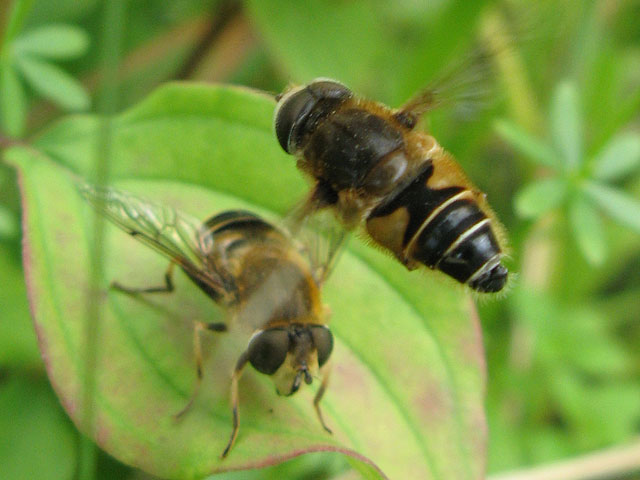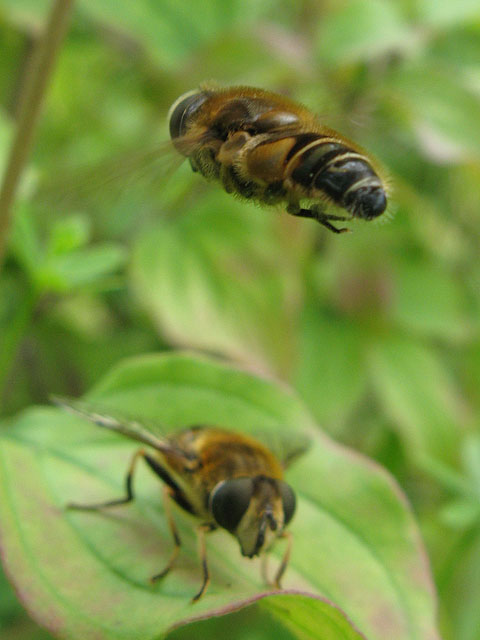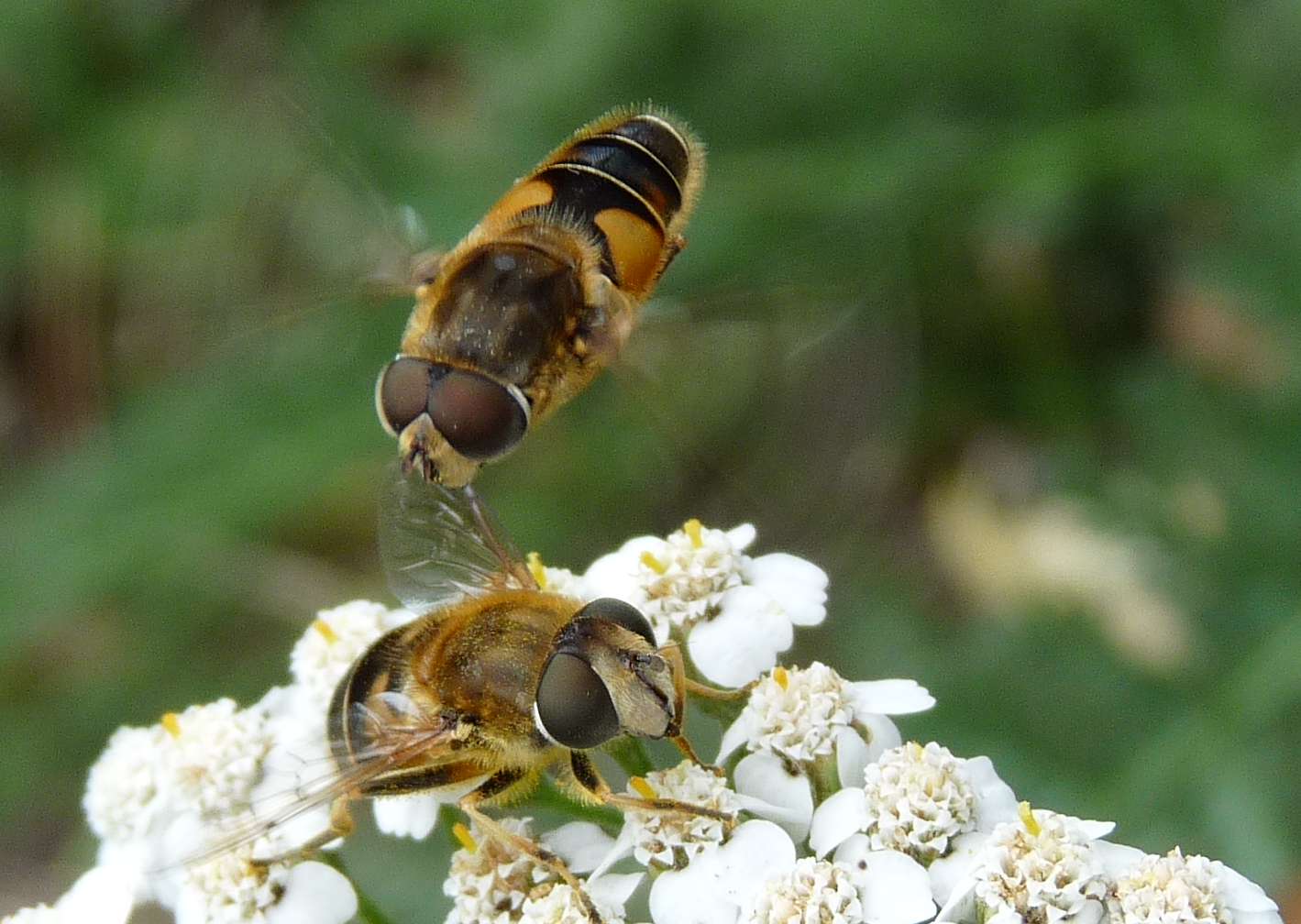Diptera.info :: Family forums :: Syrphidae
Who is here? 1 guest(s)
|
Courting Eristalis sp.
|
|
| ChrisR |
Posted on 03-08-2009 10:28
|
|
Super Administrator Location: Reading, England Posts: 7706 Joined: 12.07.04 |
I photographed this courting pair of Eristalis yesterday (2.viii.2009) on chalk downland in southern England. But can anyone identify the species? 
ChrisR attached the following image:  [51.78Kb] Edited by ChrisR on 03-08-2009 10:28 Manager of the UK Species Inventory in the Angela Marmont Centre for UK Biodiversity at the Natural History Museum, London. |
| ChrisR |
Posted on 03-08-2009 10:29
|
|
Super Administrator Location: Reading, England Posts: 7706 Joined: 12.07.04 |
and another angle...
ChrisR attached the following image:  [44.51Kb] Manager of the UK Species Inventory in the Angela Marmont Centre for UK Biodiversity at the Natural History Museum, London. |
| lagura |
Posted on 04-08-2009 00:40
|
|
Member Location: Helsingborg, Sweden Posts: 1241 Joined: 24.10.08 |
E. pertinax (based on the cone shaped abdomen of the male) Nice photos!  |
|
|
|
| Chris Webster |
Posted on 05-08-2009 00:24
|
|
Member Location: Reading UK Posts: 31 Joined: 07.07.07 |
That's typical behaviour for E. interruptus. Also, front tarsi look too dark for pertinax. A close-up of the wing stigma would make it certain. |
| Juergen Peters |
Posted on 05-08-2009 00:28
|
|
Member Location: northwest Germany Posts: 14364 Joined: 11.09.04 |
Hi! Chris Webster wrote: That's typical behaviour for E. interruptus. I also saw this only for E. interrupta. The males are so crazy, they also hover above much bigger E. tenax or even honey and bumble bees... 
Best regards, Jürgen -=-=-=-=-=-=-=-=-=-=-=-=-=-=-=-= Juergen Peters Borgholzhausen, Germany WWW: http://insektenfo... -=-=-=-=-=-=-=-=-=-=-=-=-=-=-=-= |
| ChrisR |
Posted on 07-08-2009 08:51
|
|
Super Administrator Location: Reading, England Posts: 7706 Joined: 12.07.04 |
Sadly, I think that's the best 2 photos I have of this pair  They were doing all this in some long vegetation and I had to reach down a long way just to get close enough - after I took these the male jumped on the female and they fell further down into the grass and then flew away. They were doing all this in some long vegetation and I had to reach down a long way just to get close enough - after I took these the male jumped on the female and they fell further down into the grass and then flew away.Thanks for the opinions though - very interesting 
Manager of the UK Species Inventory in the Angela Marmont Centre for UK Biodiversity at the Natural History Museum, London. |
| Andre |
Posted on 07-08-2009 11:21
|
|
Member Location: Tilburg, the Netherlands Posts: 2111 Joined: 18.07.04 |
Yes, also I only saw this behaviour for interrupta (Eristalis is feminin). This clearly is interrupta. Additional character: in picture 1 the short stigma is very clear. |
| Chris Webster |
Posted on 07-08-2009 21:54
|
|
Member Location: Reading UK Posts: 31 Joined: 07.07.07 |
Andre.. Sorry, interrupta, not interruptus. Although eristalis is a feminine noun, the International Commission on Zoological Nomenclature accepted in 1993 that it was regarded as masculine, then ruled in 2006 that it really was feminine. I must pay attention! |
| Juergen Peters |
Posted on 08-08-2009 17:11
|
|
Member Location: northwest Germany Posts: 14364 Joined: 11.09.04 |
Hi! The males are so crazy, they also hover above much bigger E. tenax or even honey and bumble bees... Once I tried to get this on video (AVI): http://insektenfo...eadid=9099 
Best regards, Jürgen -=-=-=-=-=-=-=-=-=-=-=-=-=-=-=-= Juergen Peters Borgholzhausen, Germany WWW: http://insektenfo... -=-=-=-=-=-=-=-=-=-=-=-=-=-=-=-= |
| Andre |
Posted on 09-08-2009 21:22
|
|
Member Location: Tilburg, the Netherlands Posts: 2111 Joined: 18.07.04 |
Crazy male in Brugge, Belgium, august 8 2009 
Andre attached the following image:  [127.64Kb] Edited by Andre on 09-08-2009 21:33 |
| Jump to Forum: |













